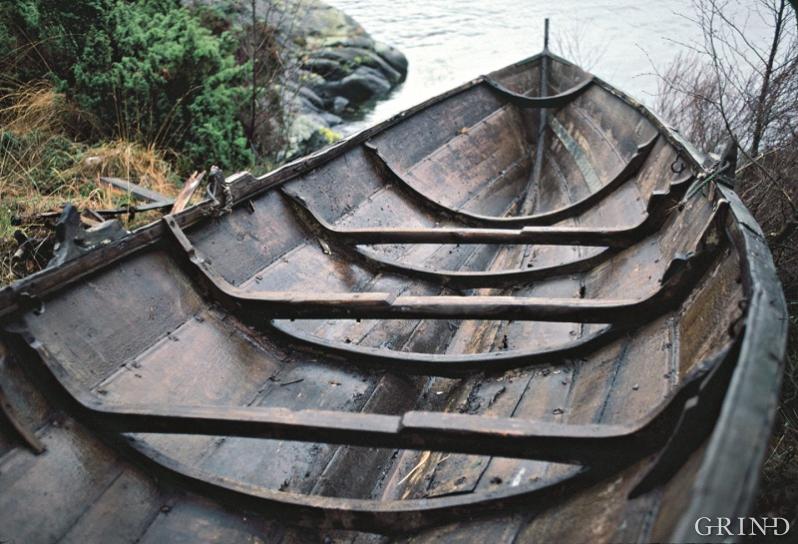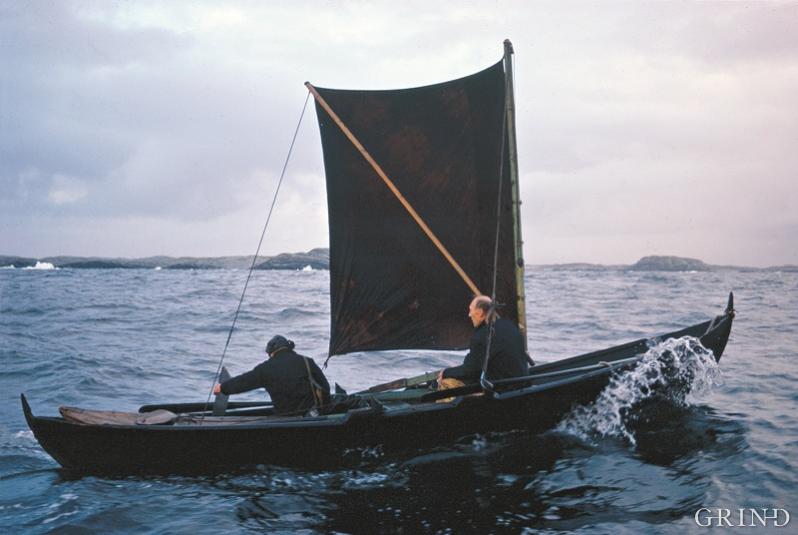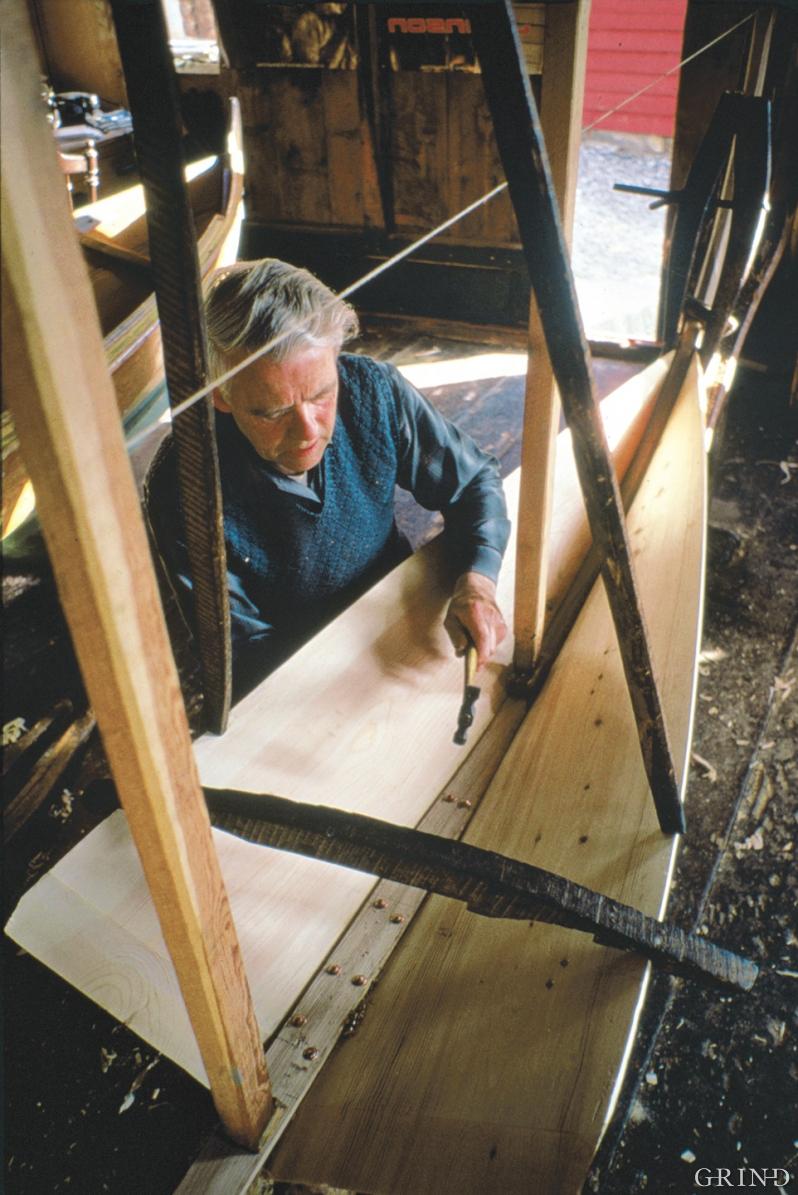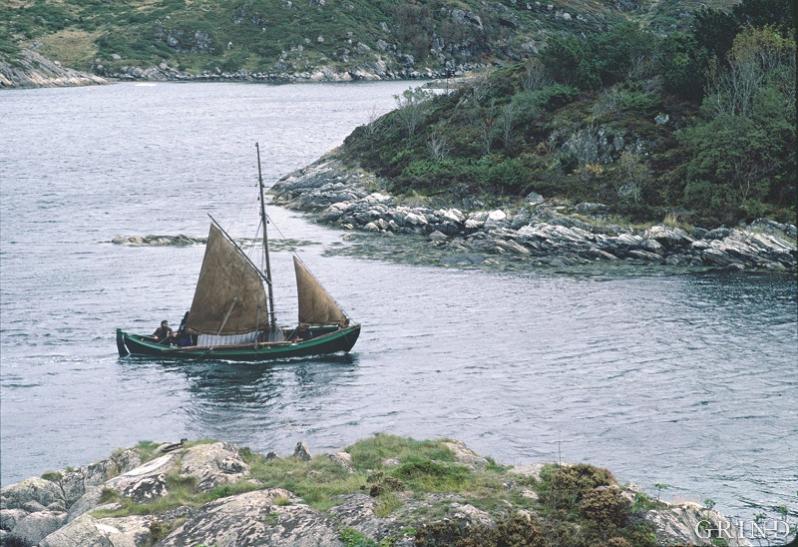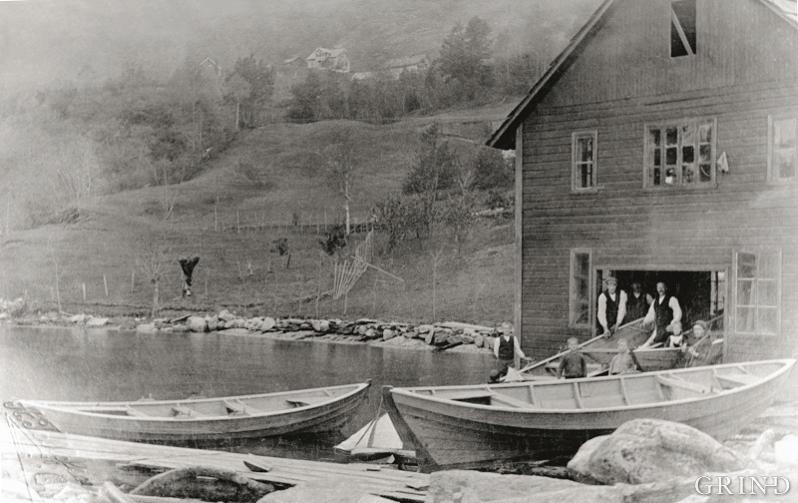Published: 19.05.2009 | Author: Arne Emil Christensen
Alfred Søvik from Lysefjorden in Os was one of the builders of Os River boats who ran the traditional handicraft work as his main occupation. (Hans-Kr. Bukholm).
If you look along the gunwales of an Oselver which takes its name from the Os River1 you will see a fine profile along the strake. It is this sort of profiles that the skilled tradesmen who built the stave churches, used. It was the same tradesmen who mastered the art of boat-building. But the lines of the Os River boat are older than the Middle Ages themselves. The Os River boat is the Norwegian boat type which most closely resembles the small boats found with the Gokstad Viking Ship from the period around 900 AD. Even older boat finds from Hordaland show that the boat-builders of the Viking times had even then a 1,000 year old tradition behind them. In the bottom of bogs in Hordaland the remains of boats almost 2000 years old have been found; amazingly like today’s forms. But how did these boat remains get there?
The remains of Norway’s oldest boat has been found in a bog at Toftevågen at Halsnøy in Sunnhordland. It has probably been sacrificed to the gods some time around 350 AD. There is not much of it left, but we can see it has been a small boat, probably a four-oared boat. The strakes have been sewn together with fishing line, and they were attached to the ribs with rope. On the uppermost planks rowlocks have been lashed on, and we can see that the form of the rowlocks has not been changed much in 2,000 years.
In heathen times it happened that the gods received a sacrifice in a holy tarn or a bog, and boats or parts of boats could be sacrificed. The heathen burial tradition required that the dead person took with him his equipment to the grave, and along the coast, both men and women were buried in boats. Usually there are only iron nails left, and everything else has rotted away, but it did happen that the boat lay in a wet bog, and then parts of the boat could have been preserved. Besides it is a fact that even today the boat builders in Hordaland store oak materials in a wet condition, usually in the sea, in an “oak-well”. A series of finds of incomplete boat keels and bows show that previously the oak materials could have been put into wet holes in the bogs, and there these materials have stayed until our own times.
At Magernes in Nordhordland the remains of several boats have been found, including rowlocks which are not so much younger than the Halsnøy boat 1. There is much to suggest that these parts are remains of a prehistoric boatyard. At Rong in Øygarden we have parts of a Viking ship, the heel of a mast and small bits of the hull as well. This has been a small ship, perhaps of the type which the Sagas call a “karve” or caravel, this was the travelling ship of the nobility. The type is best known from Gokstad, Oseberg and Tune. The ship from Rong was built in pine, probably because in this part of the country there was too little oak to be able to build vessels from only oak. From the way the remains of the ships were found, it is impossible to say with certainty whether this is a sacrifice or the remains of a shipwreck. From Sunnhordland and Midthordland we know of a group of finds from the bogs which were certainly pieces from the store; almost complete bows and keels which have been stored in a wet condition. Originally they probably lay in small tarns which were gradually grown over. For some reason or other the boat builder has never come back to fetch his materials, and they have been left lying here until they have been found in our times, usually when peat was being cut. Comparisons with other finds enable us to date these bows to the Middle Ages. Many of them have a rather special shape. Two of them have carved animal heads. The youngest of the medieval finds of bows are found together with a pair of shoes of a type which were in use about 1500.
From the next 300 years we have no find which can tell us how the boats looked, but we do know that boats were built in great numbers, for, amongst other things, export to Scotland and the Orkneys and Shetlands. The Scottish period in Sunnhordland left many traces in the place names and traditions. One trace which is still alive is the “hjeltebåt” i.e. the Shetland boat. Today nobody can tell us what a Shetland boat looked like, but “Hjaltland” is the old name for Shetland, so there is no doubt whatsoever where these boats were bound for. The treeless islands north of Scotland did not have good natural conditions for boat building, and it seems that the folk of Sunnhordland supplied what was needed in the way of smaller boats for fishing and transport right up until trade links were severed during the Napoleonic Wars. Boat building on Shetland and the Orkneys is influenced by Norwegian traditions right up until today.
It is said that the boat builders in Hordaland built with a special technique when the boats were to be exported. The least possible number of joints were used, the completed boat was marked and taken apart, and so the materials were loaded on to vessels so that several hundred boats could be carried. When these then reached Scotland, the local builders took over the “building sets” and put together the completed boats. When the export ceased there were local boat builders who did have the knowledge to continue on their own. It was mainly four-oared and six-oared boats which were shipped westwards across the sea, and there is little reason to believe that they were especially different from the boats which were built for local purchasers in the rural districts around the Bjørnefjord.
The building methods used in the building of small Norwegian boats can be traced back long before the Viking times, in an unbroken tradition. A feature of the technique was that the boats were built light and elastic. The individual planks are overlapped slightly, sewn and riveted together with small iron bolts. This gave rise to the name for the technique as “rivet-building”. The boat builders did not use construction drawings, and they had simple rules of measurement for the main dimensions of the hull. It was built up like a shell of keel, bow and planks which later had ribs and cross-beams inserted to support the shell.
Hordaland had good natural conditions for ship-building and seafaring. There is good forest near the sea in many places, and the differences in Nature between the fjord districts and the outer coast made it natural to exchange goods. Large parts of the county were also a natural hinterland for Bergen, and the city needed large supplies of goods. Today the outer coast and the smaller islands have been cleared of forest, so that we have to go further up the fjords to find natural conditions for boat building. Some of the parts of the boats found in the bogs tell of a completely different situation in the Middle Ages and in prehistoric times. In those times forest must have covered areas which are today under heath.
From the end of the 19th century we can follow boats and ship-building in Hordaland by way of preserved vessels, traditions, written sources and pictures. There are quite large differences, north and south of Bergen. The boat types are different, and few larger vessels were built north of Bergen. The boats from Masfjorden-Osterfjorden can be regarded as one type of its own, and they have more in common with the boats in Sogn og Fjordane county than with the boats further south in Hordaland. Boats were built in several places, but largely for local use. The boat type in Nordhordland is a typical fjord boat; the fishermen on the outer coast used boards from Nordfjord or Sunnhordland. Four-oared boats and six-oared boats were used for fishing around the home and small trips, eight-oared boats and ten-oared boats for going to church and for transporting farm products to Bergen. If it was a matter of transporting bigger cargoes, they had to get another vessel; an Ostra vessel. As the name suggests it came from Oster Fjord. They were built as small sloops, clinker-built and with a square sail. Similar small sloops were used for the freight of goods when people from Voss came to the sea with their products.
South of Bergen the boat type is fairly uniform over large areas, as far south as Egersund. There are differences from district to district, but as far as slightly older boats are concerned, it needs knowledge and a sharp eye to see whether it is a boat from Rogaland county, one from Sunnhordland, one from Hardanger, one from Strandebarm or one from the Os River. A common feature for all of them is that they are built from only three planks. So that it needs big forests to find enough boat planks. Today the Os river boat is built as a pleasure boat and for sailing, and the Strandebarm boat is built with a rear end for an outboard motor. The other local types are seldom built.
Before 1860 the coast of west and north Norway was a horn of plenty of different boat-types. After that time boat-builders began many places along the coast to build new boat types inspired by boats from Lista (in the south of Norway) and the boat types in Hardanger and Sunnhordland, as well as the boats from here gained a market. In competition with the boat-builders on Lista in West Agder County, the boat-builders in Sunnhordland created a new boat-type in 1860. They started off from their own traditional boats, but built with a slightly more voluminous hull which could carry heavy fishing equipment and large catches. For local transport of agricultural products to Bergen the boats were built solidly with a good load capacity; the “potato boats” from Fitjar became a byword.
Amongst the “three plankers” the boats from Os gained a particularly good reputation. The Oselver requires excellent materials, and those that are built today often have a material quality and surface treatment which is away above those of the utility boats some generations back. The fact that the boat type was used in competitive sailing in the Bergen district has gradually increased the demands for surface treatment and materials so that the boats are supplied with a “yacht finish”.
Before 1850 Norway was almost without roads, and everyone needed a boat. Special boats with a rear end and a little rear cabin were built for public servants, city folk and estate owners for travelling purposes. These semi-covered boats (vengbåt) were often extra well equipped, and often painted white, so that they distinguished themselves from the tarred boats that most people used. At Rosendal Barony three semi-covered boats which belonged to the Barony have been preserved, and the oldest one may be over 200 years old.
The Bishop of Bergen in the 1820s, Bishop Neumann, naturally used a vengboat on his tours of the district. “Most of the journeys take place on water, and whoever, during these obligatory travels seeks greater comfort than one could expect in an ordinary open boat, obtains a so-called house-boat which is somewhat longer than a usual boat, with eight, ten, twelve or more oars, with a roof or a cabin at the back, large or small, according to the tonnage of the boat. In this cabin where every room is carefully used for storing food and other such small delicacies, one sits on cushioned benches around a little table, and quite pleasantly looks through the small windows as the land glides past with each thrust of the oars, one holds the doors open to get fresh air inside in good weather, and close them to secure ourselves again bad weather when the rain pours down… In such a boat with 10 rowers and a captain and decorated with a flag and a jack and pennants, I set off on the 23rd May from the Triangle in the innermost point of the sound in Bergen to make my first official journey in Sogn’s and Søndfjord’s ecclesiastical area.”
The wooden boat has been on the decline in recent years, but as long as good forest grows near the fjord in western Norway it should be possible to maintain the two thousand year tradition in small boat building. The feeling for good handicraft work, a beautiful hull shape and seaworthy boats is a great cultural heritage to pass on, for the enjoyment and the use of new generations.
- Christensen, A. E. (1966) Frå vikingskip til motorsnekke. Norsk kulturarv, nr. 2. Oslo, Det norske samlaget.
- Diriks, C. F. (1863) Om de forskjellige Slags Baade i Norge. Folkevennen, XII. Kristiania.
- Færøyvik, Ø. & Færøyvik, B. (1987) Vestlandsbåtar: frå oselvar til sunnmørsåttring. Norske båter, nr. 5. Oslo, Grøndahl.
- Godal, J. B. (1990) Measurements, Figures and Formulas in the Interpretation of Western Norwegian Boats and Viking Ships. Acta borealia, 7 (2), s. 56-80.
- Martinussen, A. O. (1988) Båtbyggjing i Strandebarm: produksjon og omsetnad av småbåtar i Strandebarm kommune 1920 til 1940. Hovudoppgåve, Universitetet i Bergen.
- Thowsen, A. (1969) The Norwegian Export of Boats to Shetland, and its Influence upon Shetland Boatbuilding and Usage. I: Sjøfartshistorisk årbok. Bergen : Stiftelsen Bergens sjøfartsmuseum, s. 145-207.




